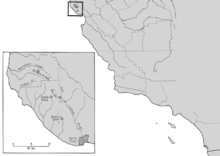Cupressus abramsiana
| Cupressus abramsiana | |
|---|---|
| Santa Cruz cypress showing stunted growth due to nutrient and moisture-poor sandstone substrate at Majors Creek, Santa Cruz Co. Ca. | |
| Scientific classification | |
| Kingdom: | Plantae |
| Division: | Pinophyta |
| Class: | Pinopsida |
| Order: | Pinales |
| Family: | Cupressaceae |
| Genus: | Cupressus |
| Species: | C. abramsiana |
| Binomial name | |
| Cupressus abramsiana C.B.Wolf 1948 | |
 | |
| Natural range of Cupressus abramsiana | |
| Synonyms | |
|
Synonymy
| |
Cupressus abramsiana, the Santa Cruz cypress, is a rare North American species of trees in the cypress family. It is endemic to the Santa Cruz Mountains of Santa Cruz and San Mateo Counties in west-central California.[1]
When cypresses were discovered in the Santa Cruz Mountains in 1881, they were first identified as Cupressus goveniana, but Jepson (1909) considered them to be Cupressus sargentii. In a detailed analysis, Wolf (1948) concluded it was a distinct species, naming it after L. R. Abrams, Emeritus Professor of Botany at Stanford University.[2]
Subsequent authors have either followed Wolf in treating it as a species (Griffin & Critchfield 1976,[3] the 1993 edition of the Jepson Manual,[4] and Lanner 1999[5]), or within Cupressus goveniana as either a variety (Cupressus goveniana var. abramsiana (C.B.Wolf) Little; as in Little (1970),[6] the Gymnosperm Database[7] and Farjon (2005)[8]), or not distinguished at all within C. goveniana (Flora of North America[9])
Santa Cruz cypress is a small evergreen tree growing to 10 meters (33 feet) (rarely to 25 meters or over 83 feet) tall. The bark is gray, with a fibrous stringy texture, shredding on old trees. The foliage is bright green to yellowish-green, with scale-like leaves 1–1.5 mm long, the leaf tips slightly spreading on vigorous shoots but not on small shoots. Seedlings bear needle-like leaves 8–10 mm long. The cones are ovoid, 20–30 mm long and 15–22 mm broad, with eight or ten scales arranged in opposite decussate pairs, with the bract visible as no more than a small lump or short spine on the scale. The seeds are 3–5 mm long, glaucous brown, with a pair of small wings along the sides.[2] The cones remain closed on the trees for many years, until the trees are killed by a forest fire; after the tree is dead, the cones open to release the seeds which can then germinate successfully on the bare fire-cleared ground.[5]
Cupressus abramsiana is in some respects intermediate between Cupressus goveniana and Cupressus sargentii in morphology, and two studies have suggested (without conclusive proof) that it could be a natural hybrid between the two.[10][11]
Cupressus abramsiana is rare in the wild, found in only five small localities in Santa Cruz County, California, and is listed as endangered.[5][12] It is separated from Cupressus goveniana in Monterey County by a gap of about 50 km, and from the also closely related Cupressus pigmaea by a gap of about 200 km (125 miles).[3] It grows at 460–1200 meters (1530–4000 feet) altitude, much higher than either C. goveniana or C. pigmaea.[8]
References
- ↑ Calflora taxon report, University of California, Hesperocyparis abramsiana (C. B. Wolf) Bartel Santa cruz cypress
- 1 2 Wolf, C. B. & Wagener, W. E. (1948). The New World Cypresses. El Aliso 1: 215–222.
- 1 2 Griffin, J. R., & Critchfield, W. B. (1976). The Distribution of Forest Trees in California' USDA Forest Service Research Paper PSW-82.
- ↑ Cupressus abramsiana in the Jepson Manual, University of California Press (1993)
- 1 2 3 Lanner, R. M. (1999). Conifers of California. Cachuma Press. ISBN 0-9628505-3-5
- ↑ Little, E. L. (1970). Names of New World Cypresses (Cupressus). Phytologia 20: 429–445.
- ↑ Gymnosperm Database
- 1 2 Farjon, A. (2005). A Monograph of Cupressaceae and Sciadopityaceae. Royal Botanic Gardens, Kew. ISBN 1-84246-068-4.
- ↑ Eckenwalder, J. E., in Flora of North America
- ↑ McMillan, C. (1951). A third locality for Cupressus abramsiana Wolf. Madroño 11: 189–194.
- ↑ Zavarin, E., Lawrence, L., & Thomas, M. C. (1971). Compositional variations of leaf monoterpenes in Cupressus macrocarpa, C. pygmaea, C. goveniana, C. abramsiana and C. sargentii. Phytochemistry 10: 379–393.
- ↑ IUCN status report.
